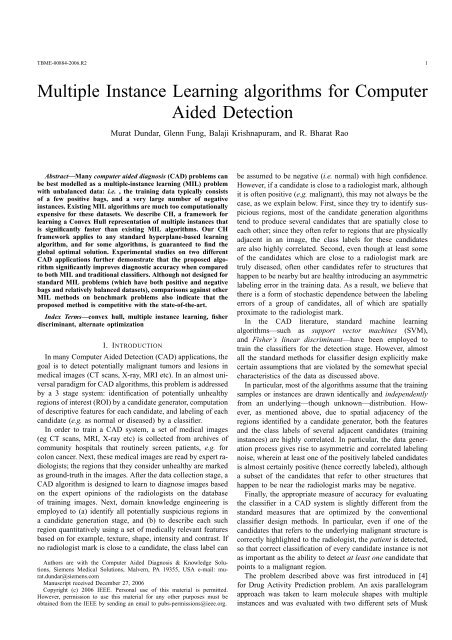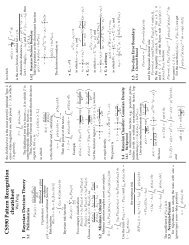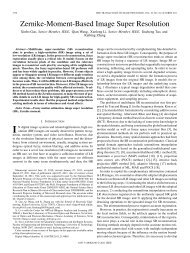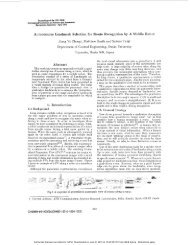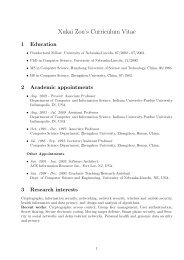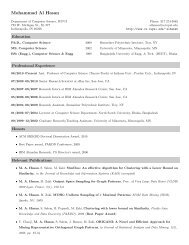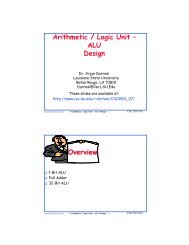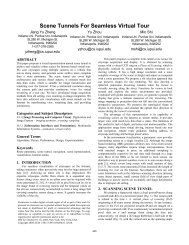Multiple Instance Learning algorithms for ... - Dr. Murat Dundar
Multiple Instance Learning algorithms for ... - Dr. Murat Dundar
Multiple Instance Learning algorithms for ... - Dr. Murat Dundar
You also want an ePaper? Increase the reach of your titles
YUMPU automatically turns print PDFs into web optimized ePapers that Google loves.
TBME-00884-2006.R2 1<br />
<strong>Multiple</strong> <strong>Instance</strong> <strong>Learning</strong> <strong>algorithms</strong> <strong>for</strong> Computer<br />
Aided Detection<br />
<strong>Murat</strong> <strong>Dundar</strong>, Glenn Fung, Balaji Krishnapuram, and R. Bharat Rao<br />
Abstract—Many computer aided diagnosis (CAD) problems can<br />
be best modelled as a multiple-instance learning (MIL) problem<br />
with unbalanced data: i.e. , the training data typically consists<br />
of a few positive bags, and a very large number of negative<br />
instances. Existing MIL <strong>algorithms</strong> are much too computationally<br />
expensive <strong>for</strong> these datasets. We describe CH, a framework <strong>for</strong><br />
learning a Convex Hull representation of multiple instances that<br />
is significantly faster than existing MIL <strong>algorithms</strong>. Our CH<br />
framework applies to any standard hyperplane-based learning<br />
algorithm, and <strong>for</strong> some <strong>algorithms</strong>, is guaranteed to find the<br />
global optimal solution. Experimental studies on two different<br />
CAD applications further demonstrate that the proposed algorithm<br />
significantly improves diagnostic accuracy when compared<br />
to both MIL and traditional classifiers. Although not designed <strong>for</strong><br />
standard MIL problems (which have both positive and negative<br />
bags and relatively balanced datasets), comparisons against other<br />
MIL methods on benchmark problems also indicate that the<br />
proposed method is competitive with the state-of-the-art.<br />
Index Terms—convex hull, multiple instance learning, fisher<br />
discriminant, alternate optimization<br />
I. INTRODUCTION<br />
In many Computer Aided Detection (CAD) applications, the<br />
goal is to detect potentially malignant tumors and lesions in<br />
medical images (CT scans, X-ray, MRI etc). In an almost universal<br />
paradigm <strong>for</strong> CAD <strong>algorithms</strong>, this problem is addressed<br />
by a 3 stage system: identification of potentially unhealthy<br />
regions of interest (ROI) by a candidate generator, computation<br />
of descriptive features <strong>for</strong> each candidate, and labeling of each<br />
candidate (e.g. as normal or diseased) by a classifier.<br />
In order to train a CAD system, a set of medical images<br />
(eg CT scans, MRI, X-ray etc) is collected from archives of<br />
community hospitals that routinely screen patients, e.g. <strong>for</strong><br />
colon cancer. Next, these medical images are read by expert radiologists;<br />
the regions that they consider unhealthy are marked<br />
as ground-truth in the images. After the data collection stage, a<br />
CAD algorithm is designed to learn to diagnose images based<br />
on the expert opinions of the radiologists on the database<br />
of training images. Next, domain knowledge engineering is<br />
employed to (a) identify all potentially suspicious regions in<br />
a candidate generation stage, and (b) to describe each such<br />
region quantitatively using a set of medically relevant features<br />
based on <strong>for</strong> example, texture, shape, intensity and contrast. If<br />
no radiologist mark is close to a candidate, the class label can<br />
Authors are with the Computer Aided Diagnosis & Knowledge Solutions,<br />
Siemens Medical Solutions, Malvern, PA 19355, USA e-mail: murat.dundar@siemens.com<br />
Manuscript received December 27, 2006<br />
Copyright (c) 2006 IEEE. Personal use of this material is permitted.<br />
However, permission to use this material <strong>for</strong> any other purposes must be<br />
obtained from the IEEE by sending an email to pubs-permissions@ieee.org.<br />
be assumed to be negative (i.e. normal) with high confidence.<br />
However, if a candidate is close to a radiologist mark, although<br />
it is often positive (e.g. malignant), this may not always be the<br />
case, as we explain below. First, since they try to identify suspicious<br />
regions, most of the candidate generation <strong>algorithms</strong><br />
tend to produce several candidates that are spatially close to<br />
each other; since they often refer to regions that are physically<br />
adjacent in an image, the class labels <strong>for</strong> these candidates<br />
are also highly correlated. Second, even though at least some<br />
of the candidates which are close to a radiologist mark are<br />
truly diseased, often other candidates refer to structures that<br />
happen to be nearby but are healthy introducing an asymmetric<br />
labeling error in the training data. As a result, we believe that<br />
there is a <strong>for</strong>m of stochastic dependence between the labeling<br />
errors of a group of candidates, all of which are spatially<br />
proximate to the radiologist mark.<br />
In the CAD literature, standard machine learning<br />
<strong>algorithms</strong>—such as support vector machines (SVM),<br />
and Fisher’s linear discriminant—have been employed to<br />
train the classifiers <strong>for</strong> the detection stage. However, almost<br />
all the standard methods <strong>for</strong> classifier design explicitly make<br />
certain assumptions that are violated by the somewhat special<br />
characteristics of the data as discussed above.<br />
In particular, most of the <strong>algorithms</strong> assume that the training<br />
samples or instances are drawn identically and independently<br />
from an underlying—though unknown—distribution. However,<br />
as mentioned above, due to spatial adjacency of the<br />
regions identified by a candidate generator, both the features<br />
and the class labels of several adjacent candidates (training<br />
instances) are highly correlated. In particular, the data generation<br />
process gives rise to asymmetric and correlated labeling<br />
noise, wherein at least one of the positively labeled candidates<br />
is almost certainly positive (hence correctly labeled), although<br />
a subset of the candidates that refer to other structures that<br />
happen to be near the radiologist marks may be negative.<br />
Finally, the appropriate measure of accuracy <strong>for</strong> evaluating<br />
the classifier in a CAD system is slightly different from the<br />
standard measures that are optimized by the conventional<br />
classifier design methods. In particular, even if one of the<br />
candidates that refers to the underlying malignant structure is<br />
correctly highlighted to the radiologist, the patient is detected,<br />
so that correct classification of every candidate instance is not<br />
as important as the ability to detect at least one candidate that<br />
points to a malignant region.<br />
The problem described above was first introduced in [4]<br />
<strong>for</strong> <strong>Dr</strong>ug Activity Prediction problem. An axis parallelogram<br />
approach was taken to learn molecule shapes with multiple<br />
instances and was evaluated with two different sets of Musk
TBME-00884-2006.R2 2<br />
Datasets with the goal of differentiating molecules that smell<br />
”musky” from the rest of the molecules. Later on this problem<br />
has been studied widely [1], [10], [13], [16] and the application<br />
domain was extended to include other interesting applications<br />
such as the image retrieval problem. The multiple instance<br />
learning problem as described in this study is slightly different<br />
than the previous descriptions <strong>for</strong> two reasons. First, in CAD<br />
we do not have the concept of negative bag, i.e. each negative<br />
instance itself is a bag and second we don’t have a unique<br />
target concept, i.e. the lesion can appear in different shapes<br />
and characteristics. The convex-hull idea presented in this<br />
paper to represent each bag is similar in nature to the one<br />
presented in [8]. However in contrast with [8] and many other<br />
approaches in the literature [4], [1], [13] our <strong>for</strong>mulation leads<br />
to a strongly convex minimization problem that converges<br />
to a unique minimizer. Since our algorithm considers each<br />
negative instance as an individual bag, it is complexity is<br />
square proportional to the number of positive instances only<br />
which makes it scalable to large datasets with large number<br />
of negative examples.<br />
In Section II we present a novel convex-hull-based MIL<br />
algorithm. In Section III we provide experimental evidence<br />
from two different CAD problems to show that the proposed<br />
algorithm is significantly faster than other MIL <strong>algorithms</strong>,<br />
and more accurate when compared to other MIL <strong>algorithms</strong><br />
and to traditional classifiers. Further—although this is not<br />
the main focus of our paper—on traditional benchmarks <strong>for</strong><br />
MIL, our algorithm is again shown to be competitive with the<br />
current state-of-the-art. We conclude with a description of the<br />
relationship to previous work, review of our contributions, and<br />
directions <strong>for</strong> future research in Section IV.<br />
II. NOVEL MIL ALGORITHMS<br />
Almost all the standard classification methods explicitly<br />
assume that the training samples (i.e., candidates) are drawn<br />
identically and independently from an underlying—though<br />
unknown—distribution. This property is clearly violated in a<br />
CAD dataset, due to spatial adjacency of the regions identified<br />
by a candidate generator, both the features and the class labels<br />
of several adjacent candidates (training instances) are highly<br />
correlated. First, because the candidate generators <strong>for</strong> CAD<br />
problems are trying to identify potentially suspicious regions,<br />
they tend to produce many candidates that are spatially close to<br />
each other; since these often refer to regions that are physically<br />
adjacent in an image, the class labels <strong>for</strong> these candidates are<br />
also highly correlated. Second, because candidates are labelled<br />
positive if they are within some pre-determined distance<br />
from a radiologist mark, multiple positive candidates could<br />
correspond with the same (positive) radiologist mark on the<br />
image. Note that some of the positively labelled candidates<br />
may actually refer to healthy structures that just happen to be<br />
near a mark, thereby introducing an asymmetric labeling error<br />
in the training data.<br />
In MIL terminology from previous literature [4], a “bag”<br />
may contain many observation instances of the same underlying<br />
entity, and every training bag is provided a class label<br />
(e.g. positive or negative). The objective in MIL is to learn<br />
a classifier that correctly classifies at least one instance from<br />
every bag. This corresponds perfectly with the the appropriate<br />
measure of accuracy <strong>for</strong> evaluating the classifier in a CAD<br />
system. In particular, even if one of the candidates that refers<br />
to the underlying malignant structure (radiologist mark) is<br />
correctly highlighted to the radiologist, the malignant structure<br />
is detected; i.e. , the correct classification of every candidate<br />
instance is not as important as the ability to detect at least<br />
one candidate that points to a malignant region. Furthermore,<br />
we would like to classify every sample that is distant from<br />
radiologist mark as negative, this is easily accomplished by<br />
considering each negative candidate as a bag. There<strong>for</strong>e, it<br />
would appear that MIL <strong>algorithms</strong> should outper<strong>for</strong>m traditional<br />
classifiers on CAD datasets.<br />
Un<strong>for</strong>tunately, in practice, most of the conventional MIL<br />
<strong>algorithms</strong> are computationally quite inefficient, and some of<br />
them have problems with local minima. In CAD we typically<br />
have several thousand mostly negative candidates (instances)<br />
[3], and a few hundred positive bags; existing MIL <strong>algorithms</strong><br />
are simply unable to handle such large datasets due to time or<br />
memory requirements.<br />
Notation: Let the i-th bag of class j be represented by<br />
the matrix Bi j ∈ ℜmi<br />
j ×n ,i = 1,...,rj , j ∈ {±1}, n is the<br />
number of features, rj is the number of bags in class j. The<br />
row l of Bi j , denoted by Bil j represents the datapoint l of the<br />
bag i in class j with l = 1,...,m i j . The binary bag-labels are<br />
specified by a vector d ∈ {±1} rj . The vector e represent a<br />
vector with all its elements one.<br />
A. Key idea: Relaxation of MIL via Convex-Hulls<br />
The original MIL problem requires at least one of the<br />
samples in a bag to be correctly labeled by the classifier: this<br />
corresponds to a set of discrete constraints on the classifier. By<br />
contrast, we shall relax this and require that at least one point<br />
in the convex hull of a bag of samples (including, possibly<br />
one of the original samples) has to be correctly classified.<br />
Figure 1 illustrates the idea using a graphical toy example.<br />
In this example there are three positive bags each with five<br />
instances and displayed as circles. The goal is to distinguish<br />
these positive bags from the negative bags, all of which exist<br />
as a single instance and are displayed by the diamonds in the<br />
figure. One of the instances in the positive bags happens to<br />
be an outlier. These are the circles at the right side of the<br />
figure farthest from the rest of the circles. The convex hulls<br />
spanned by the instances of each of the bag are shown with the<br />
polyhedrons in the figure. The MIL algorithm learns a point<br />
within the convex hull of each of the bag (shown with the<br />
stars) while maximizing the margin between the positive and<br />
negative bags. This convex-hull relaxation (first introduced in<br />
[8]) eliminates the combinatorial nature of the MIL problem,<br />
allowing <strong>algorithms</strong> that are more computationally efficient.<br />
As mentioned above, we will consider that a bag Bi j is<br />
correctly classified if any point inside the convex hull of<br />
the bag Bi j (i.e. any convex combination of points of Bi j )<br />
is correctly classified. Let λ s.t. 0 ≤ λ i j ,e′ λ i j<br />
= 1 be the<br />
vector containing the coefficients of the convex combination<br />
that defines the representative point of bag i in class j. Let r be
TBME-00884-2006.R2 3<br />
1<br />
0.9<br />
0.8<br />
0.7<br />
0.6<br />
0.5<br />
0.4<br />
0.3<br />
0.2<br />
0.1<br />
0<br />
0 0.2 0.4 0.6 0.8 1<br />
Fig. 1. A toy example illustrating the proposed approach. Positive and negative<br />
classes are represented by circles and diamonds respectively. Polyhedrons<br />
represent the convex hulls <strong>for</strong> the three positives bags, the points chosen by<br />
our algorithm to represent each bag is shown by stars. The gray line represents<br />
the linear hyperplane obtained by our algorithm and the black line represents<br />
the hyperplane <strong>for</strong> the SVM.<br />
the total number of representative points, i.e. r = r++r−. Let<br />
γ be the total number of convex hull coefficients corresponding<br />
to the representative points in class j, i.e. γj = rj i=1 mij ,<br />
γ = γ+ + γ−. Then, we can <strong>for</strong>mulate the MIL problem as,<br />
min<br />
(ξ,w,η,λ)∈R r+n+1+γ<br />
νE(ξ) + Φ(w,η) + Ψ(λ)<br />
s.t. ξi = di − (λi jBi jw − eη)<br />
ξ ∈ Ω<br />
e ′ λi j = 1<br />
0 ≤ λi j<br />
(1)<br />
Where ξ = {ξ1,...,ξr} are slack terms (errors), η is the bias<br />
(offset from origin) term, and λ is a vector containing all the<br />
λi j <strong>for</strong> i = 1,...,rj, j ∈ {±}. E : ℜr ⇒ ℜ represents the loss<br />
function, Φ : ℜ (n+1) ⇒ ℜ is a regularization function on the<br />
hyperplane coefficients [14] and Ψ is a regularization function<br />
on the convex combination coefficients λi j . Depending on the<br />
choice of E,Φ,Ψ and Ω, (1) will lead to MIL versions of<br />
several well-known classification <strong>algorithms</strong>.<br />
1) E(ξ) = (ξ)+ 2<br />
2 , Φ(w,η) = (w,η)2 2 and Ω = ℜr+ ,<br />
leads to MIL versions of the Quadratic-Programming-<br />
SVM [9].<br />
2) E(ξ) = (ξ) 2<br />
2 , Φ(w,η) = (w,η)2 2 and Ω = ℜr ,<br />
leads to MIL versions of the Least-Squares-SVM.<br />
3) ν = 1, E(ξ) = ξ 2<br />
2 , Ω = {ξ : e′ ξj = 0, j ∈ {±}}<br />
leads to MIL versions of the QP <strong>for</strong>mulation <strong>for</strong> Fisher’s<br />
linear discriminant (FD) [11].<br />
As an example, we derive a special case of the algorithm <strong>for</strong><br />
the Fisher’s Discriminant, because this choice (FD) brings us<br />
some algorithmic as well as computational advantages.<br />
B. Convex-Hull MIL <strong>for</strong> Fisher’s Linear Discriminant<br />
Setting ν = 1, E(ξ) = ξ 2<br />
2 , Ω = {ξ : e′ ξj = 0, j ∈ {±}}<br />
in (1) we obtain the following MIL version of the quadratic<br />
programming algorithm <strong>for</strong> Fisher’s Linear Discriminant [11].<br />
min<br />
(ξ,w,η,λ)∈R r+n+1+γ<br />
ξ 2<br />
2<br />
+ Φ(w,η) + Ψ(λ)<br />
s.t. ξi = di − (λi jBi jw − eη)<br />
e ′ ξj = 0<br />
e ′ λi j = 1<br />
0 ≤ λi j<br />
The number of variables to be optimized in (2) is r+n+1+γ:<br />
this is computationally infeasible when the number of bags is<br />
large (r > 104 ). To alleviate the situation, we (a) replace ξi by<br />
di − (λi jBi jw − eη) in the objective function, and (b) replace<br />
the equality constraints e ′ ξj = 0 by w ′ (µ+ − µ−) = 2. This<br />
substitution eliminates the variables ξ,η from the problem<br />
and also the corresponding r equality constraints in (2).<br />
Effectively, this results in the MIL version of the traditional FD<br />
algorithm. As discussed later in the paper, in addition to the<br />
obvious computational gains, this manipulation results in some<br />
algorithmic advantages as well (For more in<strong>for</strong>mation on the<br />
equivalence between the single instance learning versions of<br />
(2) and (3) see [11]). Thus, the optimization problem reduces<br />
to:<br />
min<br />
(w, λ)∈R n+γ<br />
w T SWw + Φ(w) + Ψ(λ)<br />
s.t. wT (µ+ − µ−)<br />
e<br />
= b<br />
′ λi j<br />
0<br />
=<br />
≤<br />
1<br />
λi j<br />
(3)<br />
where SW = <br />
j∈{±} 1<br />
rj (Xj − µje ′ ) (Xj − µje ′ ) T is the<br />
within class scatter matrix, µj = 1<br />
rj Xje is the mean <strong>for</strong> class<br />
j. Xj ∈ ℜ rj×n is a matrix containing the rj representative<br />
points on n-dimensional space such that the row of Xj denoted<br />
by bi j = Bi jλij is the representative point of bag i in class j<br />
where i = {1,...,rj} and j ∈ {±}.<br />
C. Alternate Optimization <strong>for</strong> Convex-Hull MIL Fisher’s Discriminant<br />
The proposed mathematical program (3) can be solved using<br />
an efficient Alternate Optimization (AO) algorithm [2]. In the<br />
AO setting the main optimization problem is subdivided in two<br />
smaller or easier subproblems that depend on disjoints subsets<br />
of the original variables. When Φ(w) and Ψ(λ) are strongly<br />
convex functions, both the original obingtive function and the<br />
two subproblems (<strong>for</strong> optimizing λ and w) in (3) are strongly<br />
convex, meaning that the algorithm converges to a global<br />
minimizer [15]. For computational efficiency, in the remainder<br />
of the paper we will use the regularizers Φ(w) = ǫ w 2<br />
2 and<br />
Ψ(λ) = ǫ λ 2<br />
2 , where ǫ is a positive regularization parameter.<br />
An efficient AO algorithm <strong>for</strong> solving the mathematical<br />
program (3) is described below.<br />
Sub Problem 1: Fix λ = λ∗ : When we fix λ = λ∗ , the<br />
problem becomes,<br />
min<br />
w∈R n<br />
wT SWw + Φ(w)<br />
s.t. w T (µ+ − µ−) = b<br />
which is the <strong>for</strong>mulation <strong>for</strong> the Fisher’s Discriminant. Since<br />
SW is the sum of two covariance matrices, it is guaranteed<br />
to be at least positive semidefinite and thus the problem in<br />
(2)<br />
(4)
TBME-00884-2006.R2 4<br />
(4) is convex. For datasets with r >> n, i.e. the number of<br />
bags is much greater than the number of dimensionality, SW is<br />
positive definite and thus the problem in (4) is strictly convex.<br />
Unlike (1) where the number of constraints is proportional to<br />
the number of bags, eliminating ξ and η leaves us with only<br />
one constraint. This changes the order of complexity from<br />
O(nr 2 ) to O(n 2 r) and brings some computational advantages<br />
when dealing with datasets with r >> n.<br />
Sub Problem 2: Fix w = w ∗ : When we fix w = w ∗ , the<br />
problem becomes<br />
min<br />
λ∈R γ<br />
λ T ¯ SWλ + Ψ(λ)<br />
s.t. λT (¯µ+ − ¯µ−) = b<br />
e ′ λi j = 1<br />
0 ≤ λi j<br />
where ¯ SW and ¯µ are defined as in (4) with Xj replaced by<br />
¯Xj where ¯ Xj ∈ ℜ rj×γ is now a matrix containing the rj<br />
new points on the γ-dimensional space such that the row of<br />
¯Xj denoted by ¯b i j is a vector with its nonzero elements set to<br />
B i j w∗ . For the positive class elements i−1<br />
k=1 mk + + 1 through<br />
i<br />
k=1 mk + of ¯ b i j<br />
are nonzero, <strong>for</strong> the negative class nonzero<br />
elements are located at r+ k=1 mk + + i−1 k=1 mk− + 1 through<br />
r+ k=1 mk + + i k=1 mk−. Note that ¯ SW is also a sum of two<br />
covariance matrices, it is positive semidefinite and thus the<br />
problem in (5) is convex. Unlike sub problem 1 the positive<br />
definiteness of ¯ SW does not depend on the data, since it always<br />
true that r ≤ γ. The complexity of (5) is O(nγ2 ).<br />
As it was mentioned be<strong>for</strong>e, in CAD applications, a bag<br />
is defined as a set of candidates that are spatially close<br />
to the radiologist marked ground-truth. Any candidate that<br />
is spatially far from this location is considered negative in<br />
the training data, there<strong>for</strong>e the concept of bag <strong>for</strong> negative<br />
examples does not make any practical sense in this scenario.<br />
Moreover, since ground truth is only available on the training<br />
set, there is no concept of a bag on the test set <strong>for</strong> both<br />
positive and negative examples. The classifier trained in this<br />
framework classifies and labels test instances individually -<br />
the bag in<strong>for</strong>mation in the training data is only used as a<br />
prior in<strong>for</strong>mation to obtain a more robust classifier. Hence,<br />
the problem in (5) can be simplified to account <strong>for</strong> these<br />
practical observations resulting in an optimization problem<br />
with O(nγ2 +) complexity. The entire algorithm is summarized<br />
below <strong>for</strong> clarity.<br />
D. CH-FD: An Algorithm <strong>for</strong> <strong>Learning</strong> Convex Hull Representation<br />
of <strong>Multiple</strong> <strong>Instance</strong>s<br />
(0) Choose as initial guess <strong>for</strong> λ i0 = e<br />
m i , ∀i = 1,...,r, set<br />
counter c=0.<br />
(i) For fixed λ ic , ∀i = 1,...,r solve <strong>for</strong> w c in (4).<br />
(ii) Fixing w = w c solve <strong>for</strong> λ ic , ∀i = 1,...,r in (5).<br />
(iii) Stop if λ 1(c+1) − λ 1c ,...,λ r(c+1) − λ rc 2 is less than<br />
some desired tolerance. Else replace λ ic by λ i(c+1) and<br />
c by c + 1 and go to (i).<br />
The nonlinear version of the proposed algorithm can be obtained<br />
by first trans<strong>for</strong>ming the original datapoints to a kernel<br />
space spanned by all datapoints through a kernel operator, i.e.<br />
(5)<br />
K : ℜ n ⇒ ℜ ¯γ and then by optimizing (4) and (5) in this<br />
new space. Ideally ¯γ is set to γ. However when γ is large, <strong>for</strong><br />
computational reasons we can use the technique presented in<br />
[7] to limit the number of datapoints spanning this new space.<br />
This corresponds to constraining w to lie in a subspace of the<br />
kernel space.<br />
III. EXPERIMENTAL RESULTS AND DISCUSSION<br />
For the experiments in section III-A , we compare four<br />
techniques: naive Fisher’s Discriminnat (FD), CH-FD, EM-DD<br />
[16], IDAPR [4]. For IDAPR and EM-DD we used the Matlab<br />
implementation of these <strong>algorithms</strong> also used in [18]. In both<br />
experiments we used the linear version of our algorithm.<br />
Hence the only parameter that requires tuning is ν which is<br />
tuned to optimize the 10-fold Patient Cross Validation on the<br />
training data,. All <strong>algorithms</strong> are trained on the training data<br />
and then tested on the sequestered test data. The resulting<br />
Receiver Operating Characteristics (ROC) plots are obtained<br />
by trying different values of the parameters (τ,ǫ) <strong>for</strong> IDAPR,<br />
and by thresholding the corresponding output <strong>for</strong> each of the<br />
EM-DD, FD and CH-FD.<br />
A. Two CAD Datasets: Pulmonary Embolism & Colon Cancer<br />
Detection<br />
Next, we present the problems that mainly motivated this<br />
work. Pulmonary embolism (PE), a potentially life-threatening<br />
condition, is a result of underlying venous thromboembolic<br />
disease. An early and accurate diagnosis is the key to survival.<br />
Computed tomography angiography (CTA) has emerged as<br />
an accurate diagnostic tool <strong>for</strong> PE, and However, there are<br />
hundreds of CT slices in each CTA study and manual reading<br />
is laborious, time consuming and complicated by various<br />
PE look-alikes. Several CAD systems are being developed<br />
to assist radiologists to detect and characterize emboli [12],<br />
[17]. At four different hospitals (two North American sites<br />
and two European sites), we collected 72 cases with 242<br />
PE bags comprised of 1069 positive candidates marked by<br />
expert chest radiologists. The cases were randomly divided<br />
into two sets: training (48 cases with 173 PE bags and 3655<br />
candidates) and testing (24 cases with 69 PE bags and 1857<br />
candidates). The test group was sequestered and only used<br />
to evaluate the per<strong>for</strong>mance of the final system. A combined<br />
total of 70 features are extracted <strong>for</strong> each candidate. These<br />
features were all image-based features and were normalized<br />
to a unit range, with a feature-specific mean. The features can<br />
be categorized into those that are indicative of voxel intensity<br />
distributions within the candidate, those summarizing distributions<br />
in neighborhood of the candidate, and those that describe<br />
the 3-D shape of the candidate and enclosing structures. When<br />
combined these features can capture candidate properties that<br />
can disambiguate typical false positives such as dark areas that<br />
result from poor mixing of bright contrast agents with blood in<br />
veins, and dark connective tissues between vessels, from true<br />
emboli. These features are not necessarily independent, and<br />
may be correlated with each other, especially with features in<br />
the same group.
TBME-00884-2006.R2 5<br />
Colorectal cancer is the third most common cancer in both<br />
men and women. It is estimated that in 2004, nearly 147,000<br />
cases of colon and rectal cancer will be diagnosed in the US,<br />
and more than 56,730 people would die from colon cancer<br />
[5]. CT colonography is emerging as a new procedure to help<br />
in early detection of colon polyps. However, reading through<br />
a large CT dataset, which typically consists of two CT series<br />
of the patient in prone and supine positions, each with several<br />
hundred slices, is time-consuming. Colon CAD [3] can play<br />
a critical role to help the radiologist avoid the missing of<br />
colon polyps. Most polyps, there<strong>for</strong>e, are represented by two<br />
candidates; one obtained from the prone view and the other<br />
one from the supine view. Moreover, <strong>for</strong> large polyps, a typical<br />
candidate generation algorithm generates several candidates<br />
across the polyp surface. The database of high-resolution CT<br />
images used in this study were obtained from seven different<br />
sites across US, Europe and Asia. The 188 patients were<br />
randomly partitioned into two groups, training comprised of:<br />
65 cases with 127 volumes, 50 polyps bags (179 positive<br />
candidates) were identified in this set with a total number of<br />
6569 negative candidates and testing comprised of 123 patients<br />
with 237 volumes, a total of 103 polyp bags (232 positive<br />
candidates) were identified in this set with a total number of<br />
12752 negative candidates. The test group was sequestered and<br />
only used to evaluate the per<strong>for</strong>mance of the final system.<br />
A total of 75 features are extracted <strong>for</strong> each candidate. Three<br />
imaging scientists contributed to this stage. These features can<br />
be grouped into three. The first group of features are derived<br />
from properties of patterns of curvature to characterize the<br />
shape, size, texture, density and symmetry. These features<br />
aim at capturing a general class of mostly symmetrical and<br />
round structures protruding inward into the lumen (air within<br />
the colon), having smooth surface and density and texture<br />
characteristics of muscle tissue. These kinds of structures<br />
exhibit symmetrical change of curvature sign about a central<br />
axis perpendicular to the objects surface. Colonic folds, on<br />
the other hand, have shapes that can be characterized as halfcylinders<br />
or paraboloids and hence do not present similar<br />
symmetry about a single axis [6]. The second group of features<br />
are based on a concept called tobogganing. Fast Tobogganing<br />
aims to quickly <strong>for</strong>m a toboggan cluster, which contains the<br />
given pixel without scanning the whole volume. It consists<br />
of two steps; <strong>for</strong> a given point the algorithm slides/climbs to<br />
its concentration and then expands from the concentration to<br />
<strong>for</strong>m a toboggan cluster. The third group of features are based<br />
on a concept called diverging gradient. In this technique first<br />
the gradient field of the image is computed. Then a filter is<br />
convolved with the gradient field at different scales to generate<br />
multiple response images. Features are extracted by further<br />
processing of these response images at different scales.<br />
The resulting Receiver Operating Characteristics (ROC)<br />
curves are displayed in Figure 2. Although <strong>for</strong> the PE dataset<br />
Figure 2 (left) IDAPR crosses over CH-FD and is more<br />
sensitive than CH-FD <strong>for</strong> extremely high number of false<br />
positives, Table I show that CH-FD is more accurate than all<br />
other methods over the entire space (AUC). Note that CAD<br />
per<strong>for</strong>mance is only valid in the clinically acceptable range,<br />
< 10fp/patient <strong>for</strong> PE, < 5fp/volume <strong>for</strong> Colon (generally<br />
there are 2 volumes per patient). In the region of clinical<br />
interest (AUC-RCI), Table I shows that CH-FD significantly<br />
outper<strong>for</strong>ms all other methods.<br />
Execution times <strong>for</strong> all the methods tested are shown in<br />
Table I. As expected, the computational cost is the cheapest<br />
<strong>for</strong> the traditional non-MIL based FD. Among MIL <strong>algorithms</strong>,<br />
<strong>for</strong> the PE data, CH-FD was roughly 2-times and 9-times as<br />
fast than IAPR and EMDD respectively, and <strong>for</strong> the much<br />
larger colon dataset was roughly 85-times and 2000-times<br />
faster, respectively(see Table I).<br />
Sensitivity<br />
Sensitivity<br />
1<br />
0.9<br />
0.8<br />
0.7<br />
0.6<br />
0.5<br />
0.4<br />
0.3<br />
0.2<br />
0.1<br />
EMDD<br />
IAPR<br />
CH−FD<br />
FD<br />
0<br />
0 10 20 30<br />
FP/Patient<br />
40 50 60<br />
1<br />
0.9<br />
0.8<br />
0.7<br />
0.6<br />
0.5<br />
0.4<br />
0.3<br />
0.2<br />
0.1<br />
CH−FD<br />
EMDD<br />
IAPR<br />
FD<br />
0<br />
0 10 20 30<br />
False positive per volume<br />
40 50 60<br />
Fig. 2. ROC curves obtained <strong>for</strong> (up) PE Testing data and (down) COLON<br />
testing Data<br />
B. Experiments on Benchmark Datasets<br />
We compare CH-FD with several state-of-the-art MIL <strong>algorithms</strong><br />
on 5 benchmark MIL datasets: 2 Musk datasets [4]<br />
and 3 Image Annotation datasets [1]. Each of these datasets<br />
contain both positive and negative bags. CH-FD (and MICA)<br />
use just the positive bag in<strong>for</strong>mation and ignore the negative<br />
bag in<strong>for</strong>mation, in effect, treating each negative instance as<br />
a separate bag. All the other MIL <strong>algorithms</strong> use both the<br />
positive and negative bag in<strong>for</strong>mation.<br />
The Musk datasets contains feature vectors describing the<br />
surfaces of low-energy shapes from molecules. Each feature<br />
vector has 166 features. The goal is to differentiate molecules
TBME-00884-2006.R2 6<br />
TABLE I<br />
COMPARISON OF 3 MIL AND ONE TRADITIONAL ALGORITHMS: COMPUTATION TIME, AUC, AND NORMALIZED AUC IN THE REGION OF CLINICAL<br />
INTEREST FOR PE AND COLON TEST DATA<br />
Algorithm Time (PE) Time (Colon) AUC (PE) AUC (Colon) AUC-RCI (PE) AUC-RCI (Colon)<br />
IAPR 184.6 689.0 0.83 0.70 0.34 0.26<br />
EMDD 903.5 16614.0 0.67 0.80 0.17 0.42<br />
CH-FD 97.2 7.9 0.86 0.90 0.50 0.69<br />
FD 0.19 0.4 0.74 0.88 0.44 0.57<br />
that smell ”musky” from the rest of the molecules. Approximately<br />
half of the molecules are known to smell musky. There<br />
are two musk datasets. MUSK1 contains 92 molecules with a<br />
total of 476 instances. MUSK2 contains 102 molecules with a<br />
total of 6598 instances. 72 of the molecules are shared between<br />
two datasets but MUSK2 dataset contain more instances <strong>for</strong><br />
the shared molecules. The Image Annotation data is composed<br />
of three different categories, . Each dataset namely Tiger,<br />
Elephant, Foxhas 100 positive bags and 100 negative bags.<br />
We set Φ(w) = ν |λ|. For the musk datasets our results<br />
are based on a Radial Basis Function (RBF) kernel<br />
K(xi,xj) = exp(−σ x − y 2 ). The kernel space is assumed<br />
to be spanned by all the datapoints in MUSK1 dataset and a<br />
subset of the datapoints in MUSK2 dataset (one tenth of the<br />
original training set is randomly selected <strong>for</strong> this purpose).<br />
The width of the kernel function and ν are tuned over a<br />
discrete set of five values each to optimize the 10-fold Cross<br />
Validation per<strong>for</strong>mance. For the Image Annotation data we use<br />
the linear version of our algorithm. We follow the benchmark<br />
experiment design and report average accuracy of 10 runs of<br />
10-fold Cross Validation in Table II. Results <strong>for</strong> other MIL<br />
<strong>algorithms</strong> from the literature are also reported in the same<br />
table. Iterated Discriminant APR (IAPR), Diverse Density<br />
(DD) [10], Expectation-Maximization Diverse Density (EM-<br />
DD) [16], Maximum Bag Margin Formulation of SVM (mi-<br />
SVM, MI-SVM) [1], Multi <strong>Instance</strong> Neural Networks (MI-<br />
NN) [13] are the techniques considered in this experiment <strong>for</strong><br />
comparison purposes. Results <strong>for</strong> mi-SVM, MI-SVM and EM-<br />
DD are taken from [1].<br />
Table II shows that CH-FD is comparable to other techniques<br />
on all datasets, even though it ignores the negative<br />
bag in<strong>for</strong>mation. Furthermore, CH-FD appears to be the most<br />
stable of the <strong>algorithms</strong>, at least on these 5 datasets, achieving<br />
the most consistent per<strong>for</strong>mance as indicated by the ”Average<br />
Rank” column. We believe that this stable behavior of our algorithm<br />
is due in part because it converges to global solutions<br />
avoiding the local minima problem.<br />
IV. CONCLUSIONS<br />
This paper makes three principal contributions. First, we<br />
have identified the need <strong>for</strong> multiple-instance learning in CAD<br />
applications and described the spatial proximity based intersample<br />
correlations in the label noise <strong>for</strong> classifier design in<br />
this setting. Second, building on an intuitive convex-relaxation<br />
of the original MIL problem, this paper presents a new approach<br />
to multiple-instance learning. In particular, we dramatically<br />
improve the run time by replacing a large set of discrete<br />
constraints (at least one instance in each bag has to be correctly<br />
classified) with infinite but continuous sets of constraints (at<br />
least one convex combination of the original instances in every<br />
bag has to be correctly classified). Further, the proposed idea<br />
<strong>for</strong> achieving convexity in the objective function of the training<br />
algorithm alleviates the problems of local maxima that occurs<br />
in some of the previous MIL <strong>algorithms</strong>, and often improves<br />
the classification accuracy on many practical datasets. Third,<br />
we present a practical implementation of this idea in the <strong>for</strong>m<br />
of a simple but efficient alternate-optimization algorithm <strong>for</strong><br />
Convex Hull based Fisher’s Discriminant. In our benchmark<br />
experiments, the resulting algorithm achieves accuracy that is<br />
comparable to the current state of the art, but at a significantly<br />
lower run time (typically several orders of magnitude speed<br />
ups were observed).<br />
ACKNOWLEDGMENT<br />
We would like to thank everyone who contributed to the<br />
Colon and PE CAD projects. Our special thanks goes to <strong>Dr</strong>.<br />
Sarang Lakare, <strong>Dr</strong>. Anna Jerebko, <strong>Dr</strong>. Senthil Periaswamy, <strong>Dr</strong>.<br />
Liang Jianming and <strong>Dr</strong>. Luca Bogoni.<br />
REFERENCES<br />
[1] S. Andrews, I. Tsochantaridis, and T. Hofmann, “Support vector machines<br />
<strong>for</strong> multiple-instance learning,” in Advances in Neural In<strong>for</strong>mation<br />
Processing Systems 15, S. T. S. Becker and K. Obermayer, Eds.<br />
Cambridge, MA: MIT Press, 2003, pp. 561–568.<br />
[2] J. Bezdek and R. Hathaway, “Convergence of alternating optimization,”<br />
Neural, Parallel Sci. Comput., vol. 11, no. 4, pp. 351–368, 2003.<br />
[3] L. Bogoni, P. Cathier, M. <strong>Dundar</strong>, A. Jerebko, S. Lakare, J. Liang,<br />
S. Periaswamy, M. Baker, and M. Macari, “Cad <strong>for</strong> colonography: A<br />
tool to address a growing need,” British Journal of Radiology, vol. 78,<br />
pp. 57–62, 2005.<br />
[4] T. G. Dietterich, R. H. Lathrop, and T. Lozano-Perez, “Solving<br />
the multiple instance problem with axis-parallel rectangles,” Artificial<br />
Intelligence, vol. 89, no. 1-2, pp. 31–71, 1997. [Online]. Available:<br />
citeseer.ist.psu.edu/dietterich97solving.html<br />
[5] D. Jemal, R. Tiwari, T. Murray, A. Ghafoor, A. Saumuels, E. Ward,<br />
E. Feuer, and M. Thun, “Cancer statistics,” CA Cancer J. Clin., vol. 54,<br />
pp. 8–29, 2004.<br />
[6] A. Jerebko, S. Lakare, P. Cathier, S. Periaswamy, and<br />
L. Bogoni, “Symmetric curvature patterns <strong>for</strong> colonic<br />
polyp detection,” in Proceedings of the 14th European<br />
Conference on Machine <strong>Learning</strong>, LNAI 2837. Copenhagen,<br />
Denmark: Springer, 2006, pp. 169–176. [Online]. Available:<br />
http://www.sigmod.org/dblp/db/conf/miccai/miccai2006-2.html<br />
[7] Y.-J. Lee and O. L. Mangasarian, “RSVM: Reduced support vector<br />
machines,” Data Mining Institute, Computer Sciences Department,<br />
University of Wisconsin, Madison, Wisconsin, Tech. Rep. 00-<br />
07, July 2000, proceedings of the First SIAM International Conference<br />
on Data Mining, Chicago, April 5-7, 2001, CD-ROM Proceedings.<br />
ftp://ftp.cs.wisc.edu/pub/dmi/tech-reports/00-07.ps.<br />
[8] O. Mangasarian and E. Wild, “<strong>Multiple</strong> instance classification via successive<br />
linear programming,” Data Mining Institute, Computer Sciences<br />
Department, University of Wisconsin, Madison, Wisconsin, Tech. Rep.<br />
05–02, 2005.
TBME-00884-2006.R2 7<br />
TABLE II<br />
AVERAGE ACCURACY ON BENCHMARK DATASETS. THE NUMBER IN PARENTHESIS REPRESENTS THE RELATIVE RANK OF EACH OF THE ALGORITHMS<br />
(PERFORMANCE-WISE) IN THE CORRESPONDING DATASET<br />
Datasets MUSK1 MUSK2 Elephant Tiger Fox Average Rank<br />
CH-FD 88.8 (2) 85.7 (2) 82.4 (2) 82.2 (2) 60.4 (2) 2<br />
IAPR 87.2 (5) 83.6 (6) - (-) - (-) - (-) 5.5<br />
DD 88.0 (3) 84.0 (5) - (-) - (-) - (-) 4<br />
EMDD 84.8 (6) 84.9 (3) 78.3 (5) 72.1 (5) 56.1 (5) 4.8<br />
mi-SVM 87.4 (4) 83.6 (6) 82.2 (3) 78.4 (4) 58.2 (3) 4<br />
MI-SVM 77.9 (8) 84.3 (4) 81.4 (4) 84.0 (1) 57.8 (4) 4.2<br />
MI-NN 88.9 (1) 82.5 (7) - (-) - (-) - (-) 4<br />
MICA 84.4 (7) 90.5 (1) 82.5 (1) 82.0(3) 62.0(1) 3.25<br />
[9] O. L. Mangasarian, “Generalized support vector machines,” in Advances<br />
in Large Margin Classifiers, A. Smola, P. Bartlett, B. Schölkopf, and<br />
D. Schuurmans, Eds. Cambridge, MA: MIT Press, 2000, pp. 135–146,<br />
ftp://ftp.cs.wisc.edu/math-prog/tech-reports/98-14.ps.<br />
[10] O. Maron and T. Lozano-Pérez, “A framework <strong>for</strong> multipleinstance<br />
learning,” in Advances in Neural In<strong>for</strong>mation Processing<br />
Systems 10, M. I. Jordan, M. J. Kearns, and S. A. Solla, Eds.,<br />
vol. 10. Cambridge, MA: MIT Press, 1998. [Online]. Available:<br />
citeseer.ist.psu.edu/maron98framework.html<br />
[11] S. Mika, G. Rätsch, and K. R. Müller, “A mathematical programming<br />
approach to the kernel fisher algorithm,” in Advances in Neural<br />
In<strong>for</strong>mation Processing Systems 12, 2000, pp. 591–597. [Online].<br />
Available: citeseer.ist.psu.edu/mika01mathematical.html<br />
[12] M. Quist, H. Bouma, C. V. Kuijk, O. V. Delden, and F. Gerritsen,<br />
“Computer aided detection of pulmonary embolism on multi-detector<br />
ct,” in Proceedings of the 90th meeting of the Radiological Society of<br />
North America (RSNA), 2004.<br />
[13] J. Ramon and L. D. Raedt, “Multi instance neural<br />
networks,” in Proceedings of ICML-2000 workshop on Attribute-<br />
Value and Relational <strong>Learning</strong>., 2000. [Online]. Available:<br />
citeseer.ist.psu.edu/ramon00multi.html<br />
[14] V. N. Vapnik, The Nature of Statistical <strong>Learning</strong> Theory. New York:<br />
Springer, 1995.<br />
[15] J. Warga, “Minimizing certain convex functions,” Journal of SIAM on<br />
Applied Mathematics, vol. 11, pp. 588–593, 1963.<br />
[16] Q. Zhang and S. Goldman, “Em-dd: An improved multiple-instance<br />
learning technique,” in Advances in Neural In<strong>for</strong>mation Processing<br />
Systems 14, T. G. Dietterich, S. Becker, and Z. Ghahramani, Eds.,<br />
vol. 14. Cambridge, MA: MIT Press, 2001, pp. 1073–1080. [Online].<br />
Available: citeseer.ist.psu.edu/article/zhang01emdd.html<br />
[17] C. Zhou, L. M. Hadjiiski, B. Sahiner, H.-P. Chan, S. Patel, P. Cascade,<br />
E. A. Kazerooni, and J. Wei, “Computerized detection of pulmonary<br />
embolism in 3D computed tomographic (CT) images: vessel tracking<br />
and segmentation techniques,” in Medical Imaging 2003: Image Processing.<br />
Edited by Sonka, Milan; Fitzpatrick, J. Michael. Proceedings of the<br />
SPIE, Volume 5032, pp. 1613-1620 (2003)., May 2003, pp. 1613–1620.<br />
[18] Z. Zhou and M. Zhang, “Ensembles of multi-instance learners,” in<br />
Proceedings of the 14th European Conference on Machine <strong>Learning</strong>,<br />
LNAI 2837. Cavtat-Dubrovnik, Croatia: Springer, 2003, pp. 492–502.<br />
[Online]. Available: citeseer.ist.psu.edu/zhou03ensembles.html<br />
<strong>Dr</strong>. M. <strong>Murat</strong> <strong>Dundar</strong> received his B.Sc. degree<br />
from Bogazici University Istanbul, Turkey, in 1997<br />
and his M.S. and Ph.D. degrees from Purdue University<br />
in 1999 and 2003 respectively, all in Electrical<br />
Engineering. Since 2003 he works as a scientist<br />
in Siemens Medical Solutions, USA. His research<br />
interests include statistical pattern recognition and<br />
computational learning with applications to computer<br />
aided detection, hyperspectral data analysis<br />
and remote sensing.<br />
<strong>Dr</strong>. Glenn Fung received B.S. degree in pure<br />
mathematics from Universidad Lisandro Alvarado<br />
in Barquisimeto, Venezuela, then earned an M.S. in<br />
applied mathematics from Universidad Simon Bolivar,<br />
Caracas, Venezuela where later he worked as<br />
an assistant professor <strong>for</strong> two years. He also earned<br />
an M.S. degree and a Ph. D. degree in computer<br />
sciences from the University of Wisconsin-Madison.<br />
His main interests are Optimization approaches to<br />
Machine <strong>Learning</strong> and Data Mining, with emphasis<br />
in Support Vector Machines. In the summer of 2003<br />
he joined the computer aided diagnosis group at Siemens, medical solutions<br />
in Malvern, PA where he has been applying Machine learning techniques to<br />
solve challenging problems that arise in the medical domain. His recent papers<br />
are available at www.cs.wisc.edu/ gfung.<br />
<strong>Dr</strong>. Balaji Krishnapuram received his B. Tech.<br />
from the Indian Institute of Technology (IIT)<br />
Kharagpur, in 1999 and his PhD from Duke University<br />
in 2004, both in Electrical Engineering. He<br />
works as a scientist in Siemens Medical Solutions,<br />
USA. His research interests include statistical pattern<br />
recognition, Bayesian inference and computational<br />
learning theory. He is also interested in applications<br />
in computer aided medical diagnosis, signal processing,<br />
computer vision and bioin<strong>for</strong>matics.<br />
<strong>Dr</strong>. R. Bharat Rao is the Senior Director of Engineering<br />
R&D, at the Computer-Aided Diagnosis<br />
and Knowledge Solutions (CKS) Solutions Group<br />
in Siemens Medical Solutions, Malvern, PA. He<br />
received his Ph.D. in machine learning from the<br />
Department of Electrical & Computer Engineering,<br />
University of Illinois, Urbana-Champaign, in 1993.<br />
<strong>Dr</strong>. Rao joined Siemens Corporate Research in 1993,<br />
and managed the Data Mining group over there from<br />
1996. In 2002, he joined the then-<strong>for</strong>med Computer-<br />
Aided Diagnosis & Therapy Group in Siemens Medical<br />
Solutions, with a particular focus on using clinical patient in<strong>for</strong>mation<br />
and data mining methods to help improve traditional computer-aided detection<br />
methods. In 2005, Siemens honored him with its ”Inventor of the Year” award<br />
<strong>for</strong> outstanding contributions related to improving the technical expertise and<br />
the economic success of the company. He also received the inaugural IEEE<br />
Data Mining Practice Prize <strong>for</strong> the best deployed industrial and government<br />
data mining application in 2005.<br />
His current research interests are focused on the use of machine learning<br />
and probabilistic inference to develop decision-support tools that can help<br />
physicians improve the quality of patient care and their efficiency. He is<br />
particularly interested in the development of novel data mining methods to<br />
collectively mine and integrate the various parts of a patient record (lab tests,<br />
pharmacy, free text, images, proteomics, etc.) and the integration of medical<br />
knowledge into the mining process.


